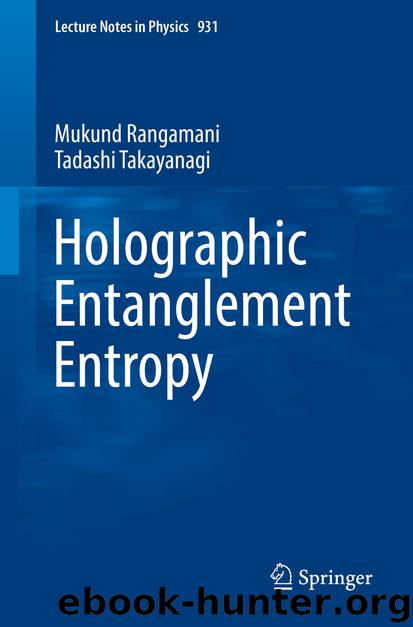Holographic Entanglement Entropy by Mukund Rangamani & Tadashi Takayanagi

Author:Mukund Rangamani & Tadashi Takayanagi
Language: eng
Format: epub
Publisher: Springer International Publishing, Cham
While we have derived the first law for entanglement entropy (8.1.11) by examining small subsystems in a holographic setting, let us now see how a general statement of the entanglement first law follows from the relative entropy in any QFT [56]. We have already indicated some of this in our discussion in Sect. 2.5, but it is instructive to re-examine those statements in light of the current discussion.
The first law of entanglement follows from the stationarity of relative entropy for perturbation about a reference state (2.5.8). It relates the linear change in the modular Hamiltonian to the change in the entanglement entropy. One way to read the expression is that a state ρ 0 is indistinguishable from another ρ 0 +ε ρ 1 to by examining the entanglement alone. In our discussion of Sect. 8.1.1, we picked an excited state, which one would expect to be clearly distinguishable from the ground state. It certainly would be if we focused on the macroscopic features of the excitation. Should we however only ask questions about relatively small subregions and the reduced density matrix induced thereon, then we are restricting attention to a very small part of the information available. The reduced density matrix for the excited state ∣E〉 is almost indistinguishable from that of the vacuum as long as we satisfy the condition outlined (8.1.4). Within this limit, one is guaranteed to find
Download
This site does not store any files on its server. We only index and link to content provided by other sites. Please contact the content providers to delete copyright contents if any and email us, we'll remove relevant links or contents immediately.
The Complete Stick Figure Physics Tutorials by Allen Sarah(7135)
Secrets of Antigravity Propulsion: Tesla, UFOs, and Classified Aerospace Technology by Ph.D. Paul A. Laviolette(4984)
Thing Explainer by Randall Munroe(3782)
The River of Consciousness by Oliver Sacks(3414)
The Order of Time by Carlo Rovelli(3073)
How To by Randall Munroe(2912)
I Live in the Future & Here's How It Works by Nick Bilton(2843)
A Brief History of Time by Stephen Hawking(2819)
What If?: Serious Scientific Answers to Absurd Hypothetical Questions by Randall Munroe(2542)
The Great Unknown by Marcus du Sautoy(2535)
Midnight in Chernobyl by Adam Higginbotham(2388)
Blockchain: Ultimate Step By Step Guide To Understanding Blockchain Technology, Bitcoin Creation, and the future of Money (Novice to Expert) by Keizer Söze(2379)
Networks: An Introduction by Newman Mark(2264)
The Meaning of it All by Richard Feynman(2213)
Easy Electronics by Charles Platt(2207)
The Tao of Physics by Fritjof Capra(2164)
Midnight in Chernobyl: The Untold Story of the World's Greatest Nuclear Disaster by Adam Higginbotham(2077)
When by Daniel H Pink(2021)
Introducing Relativity by Bruce Bassett(2018)
